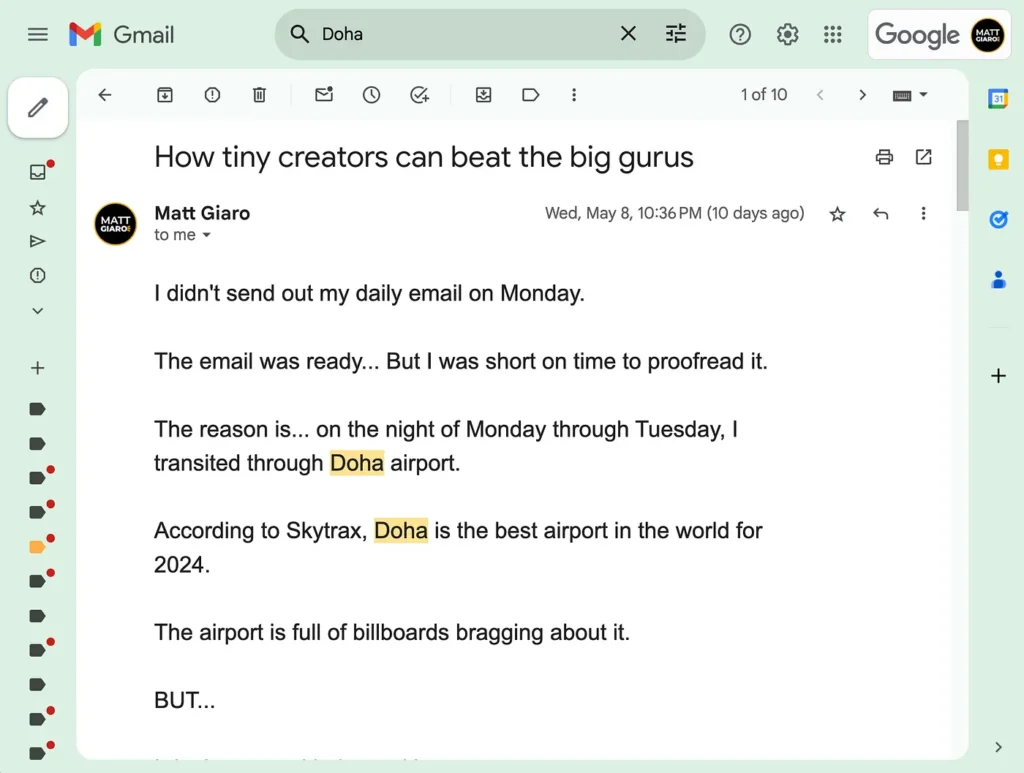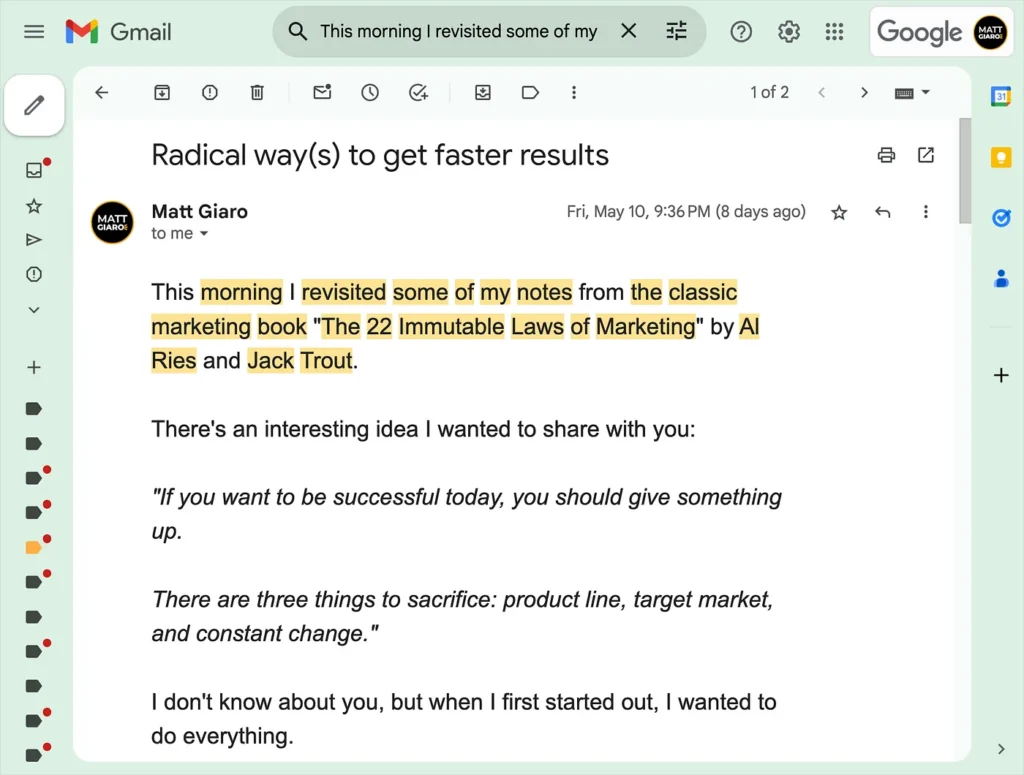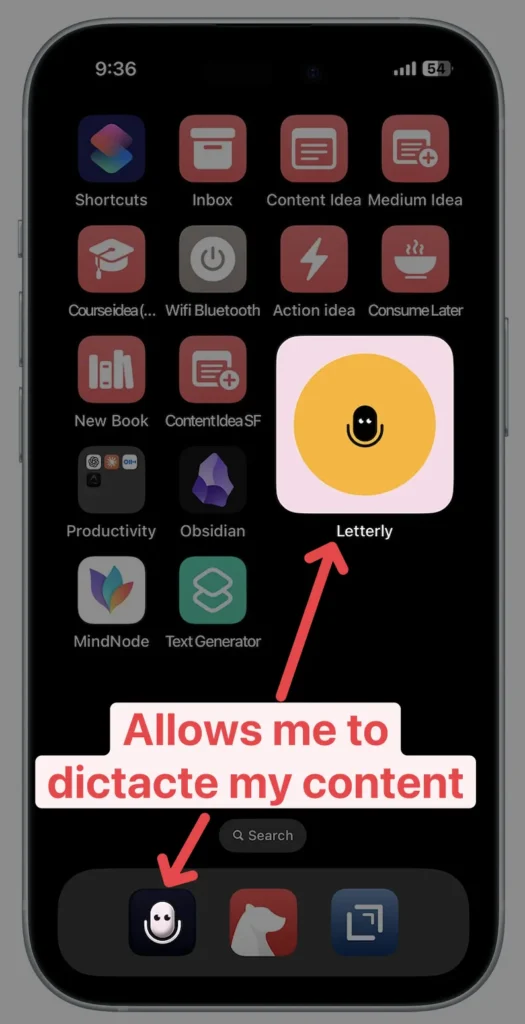If you’ve ever tried writing newsletters…
You know how much of a time drain they can be:
You spend a few hours going back and forth:
→ Deciding on a topic
→ Writing the damn thing
→ Tweaking the subject line a half-dozen times
→ Loading it into your autoresponder
→ yada, yada, yada.
But what if you could write and send your newsletter while sipping your morning coffee?
I sent my first email newsletter back in 2012. It took me 3 hours to write and was a grueling nightmare. As per writing this, I wrote over 1,752 of them.
Email newsletters account for 97% of my revenue. When I stop sending emails, I stop making money. So that’s why I’m constantly working on improving my process.
Let me show you exactly how I crank out emails that get opened, read, and clicked in 15 minutes (or less).
(And yes, it’s about writing a good newsletter people want to read.)
Step 1: Do this before you even start writing
Drafting your newsletter is the first step.
And whoever said that a newsletter should be a deep dive or weekly roundup?
It’s tempting to write newsletters like everyone else in your industry. It’s the path of least resistance. But it’s often a trap. Please resist it.
My first newsletters were listicles like: “7 tips to achieve X.”
After writing a few dozen of those, I was sick and tired. I hated them. So I ditched that format and experimented with other formats.
Eventually, I found what I liked best.
Before writing your newsletter, find a format that works for you. One you enjoy. One you can stick to no matter what.
The easier the format, the faster and more fun it will be.
Some creators pack their newsletters with 139 ideas, links, and other resources. Some write small blog posts.
I’m good with that.
But I’d never write those types of newsletters. They’re not my style.
The best way to find your newsletter format is to test a lot of different formats and see which one you enjoy the most:
- Do you love writing articles?
- Do you love sharing quick insights?
- Do you love curating other people’s stuff and providing the gist?
What I love is sharing quick insights.
So that’s what I do in my newsletter. I treat my emails like a quick and friendly chat with my reader. That’s why my emails are conversational as if I were writing them to a friend.
No fancy banners, no logos, nothing of all that branding crap. My emails look like emails — not like a blinking Christmas tree:

I learned this way of writing and formatting emails from Ben Settle.
I didn’t copy – I simply made the process my own.
Ben uses fewer line breaks, smaller fonts, and has a completely different writing style.
And Ben got inspired to write like that based on another great copywriter, Gary Halbert.
Gary had something called the A-pile B-pile concept.
Simply put, when something looks personal and not like an ad, you’re more likely to read it.
Think about it: Are you more likely to open an email from a friend or a promotional newsletter?
I go for conversational emails any day.
So instead of writing a newsletter filled with five different marketing tips, I’ll focus on one.
Easier to keep attention. Faster to write.
For instance, if the idea is “creating online courses faster by leveraging your notes,” I focus on how the right note-taking methodology can help you create a solid outline in less than 2 hours.
It’s less work for you and more enjoyable for your readers.
The key is not to blindly copy what I’m doing or what other creators do. Simply take time to find your style.
Pro tip: Keep in mind your publishing frequency. I write daily newsletters. It would be suicidal to make each email a 1,500-word article or tutorial. That would not only be overwhelming for me but also for my readers. Some people are the complete opposite.
Step 2: Create your idea bank
The worst thing that could happen to a writer is not knowing what to write about.
I never get my best ideas in front of a screen. I also have chronic back pain, so I can’t sit more than 2 hours straight at a desk.
That’s why I like to come up with ideas to write about before parking my keister in my ergonomic desk chair.
That’s where my idea bank comes into play.
The easiest way to get started is to use the note-taking app already built into your phone and start creating a “content idea” bucket (either a tag or a folder).
Then start getting into the habit of saving every idea.
I usually have ideas in embarrassing moments like when:
→ driving
→ taking a shower
→ or just before falling asleep
Some people get them when doing the dishes or meditating.
I don’t really care when you get these.
But if I tried to remember my ideas, I’d lose them. (My memory is so bad that I have issues memorizing my phone number!)
So when I have an idea, I immediately save it. As a result, I have over 1256 content ideas sitting in my note-taking app:

This way, I always have ideas to choose from. When I sit down to write, all I have to do is open my idea bank, browse through my ideas, and pick the ones that I’m most excited about writing.
There are 3 ways I like to save ideas:
1. Gather stories from everyday life
For instance, I recently transited through Doha airport.
Doha has been awarded ‘best airport in the world’ by Skytrax. This statement pissed me off because I had a stupid bad experience there.
So I wrote about it in my newsletter:

Personal experiences make for engaging content because they are unique to you. They also help in building a connection with your readers.
2. Distill notes from books, podcasts, or articles.
When I read an interesting book, I’ll jot down key insights and thoughts and distill those book notes into a note-taking app called Obsidian. This solidifies the ideas but also gives me raw material to write about.
Because one of the best ways to learn is to teach.
Here’s an example:

Having an idea bank helps you stop wasting time trying to find email ideas. Thus, you’ll never be stuck staring at a blank screen again.
Step 3: Write personal first drafts fast with AI
The internet is flooded with garbage content generated by AI. But AI is bloody useful when you don’t use it like a jerk.
Especially to crank out first drafts.
Here’s what I mean:
One of the common pieces of writing advice you’ll hear is this: “Write like you talk.”
When you write like you talk, you don’t have time to come up with overcomplex long sentences or complicated words. Yet, many creators try to sound clever. When writing, they stuff more and more info into their content.
As a result, they sound like a walking thesaurus. Their sentences are like a bowl of alphabet soup — a jumbled mess of big words that make no sense together. Forget about impressing people with your extensive lexicon. Just say what you mean, like you’re talking to your best bud over a slice of pizza.
The easiest way to write like you talk is to simply… talk. (I know, sounds crazy!)
I use an AI-powered voice dictation app on my phone called Letterly (previously, Otter.)
It automatically turns each voice note into text (that I can then re-use for my newsletter):

When I have an idea, I pull out my phone, start recording, and talk out the thought.
This usually takes 3 minutes.
A few seconds later, I have a first email draft I can export to my text editor. This is really how to write like you talk.
Once I have my first transcribed draft, I review it. Then, I make some quick edits to ensure it’s coherent and personal and talks to my readers.
This newsletter writing method slashes my writing time by half.
Step 4: Kill this habit that’ll prevent you from writing emails fast
Perfectionism has always been my biggest enemy.
I used to spend hours obsessing over every email, tweaking each word until it felt just right.
Not only does perfectionism slow you down, but it also drains your creativity. It turned the content creation process into a mental battle, leaving me exhausted and unmotivated.
When I first started writing newsletters, I thought each one had to be perfect. It took me hours to write, edit, and then trash it because of my stupid perfectionism.
I then realized that I had two choices: letting perfectionism stop me from publishing or being okay with sending out newsletters that weren’t perfect.
My newsletters sometimes have typos. They’re not 100% grammatically correct.
Who cares?
That’s what a real email from a real human looks like.
People read emails while on the toilet or stuck at a red light. They’re looking for real, relatable content, not polished masterpieces.
Each email doesn’t have to be flawless; it just needs to provide value, be entertaining, and be genuine.
So ditch Perfectionism. It’s mental garbage talk.
Make more money with easy-to-write Newsletters?
Writing emails is one of the most profitable skills you can develop.
It allows you to build a strong relationship with your audience to then monetize your expertise with online courses, coaching, or done-for-you services.
The key is to keep the process simple, fun, and lightweight, as I shared with you in this article.
Want to generate passive income with newsletters? Get my free course below:
